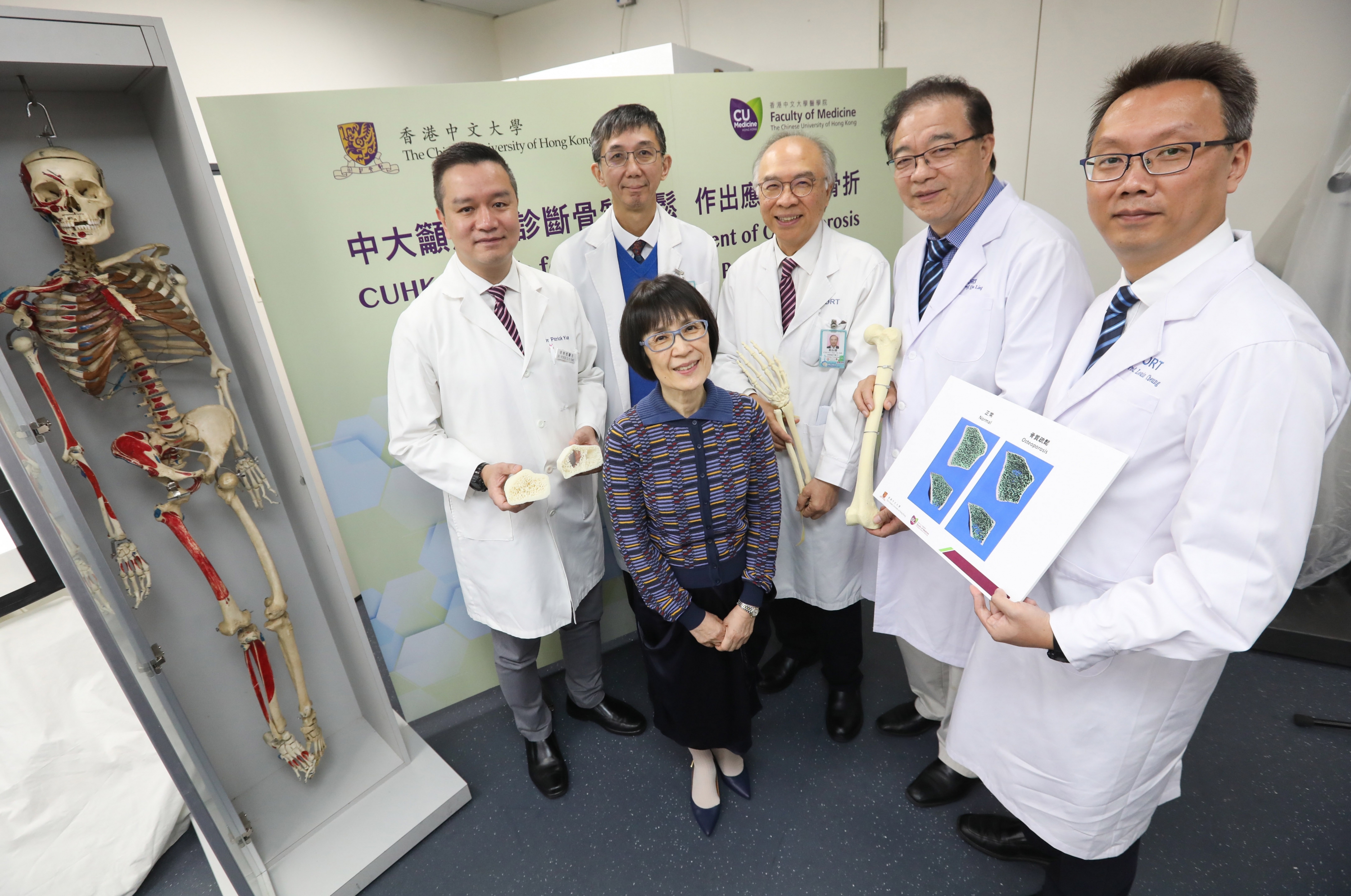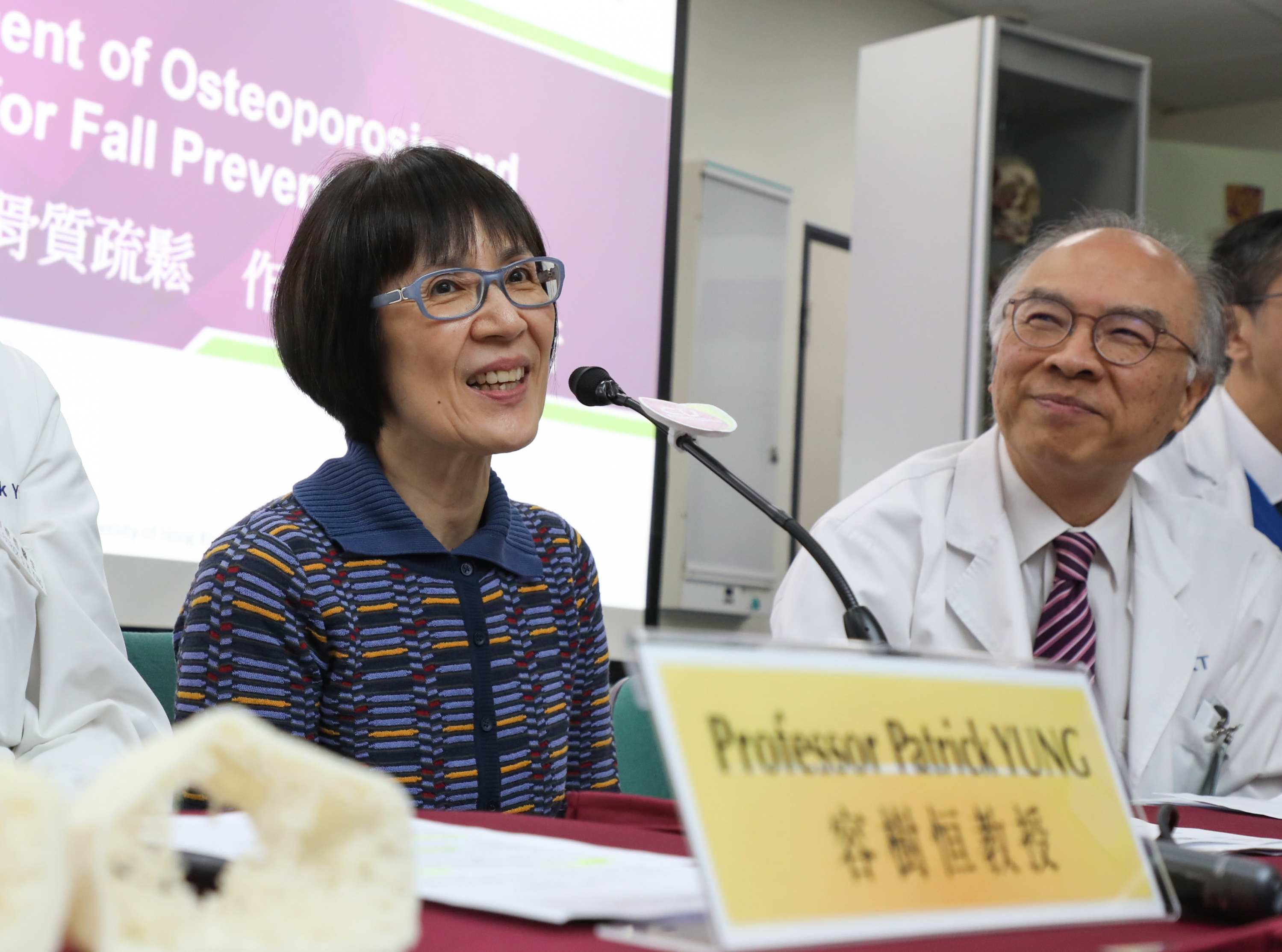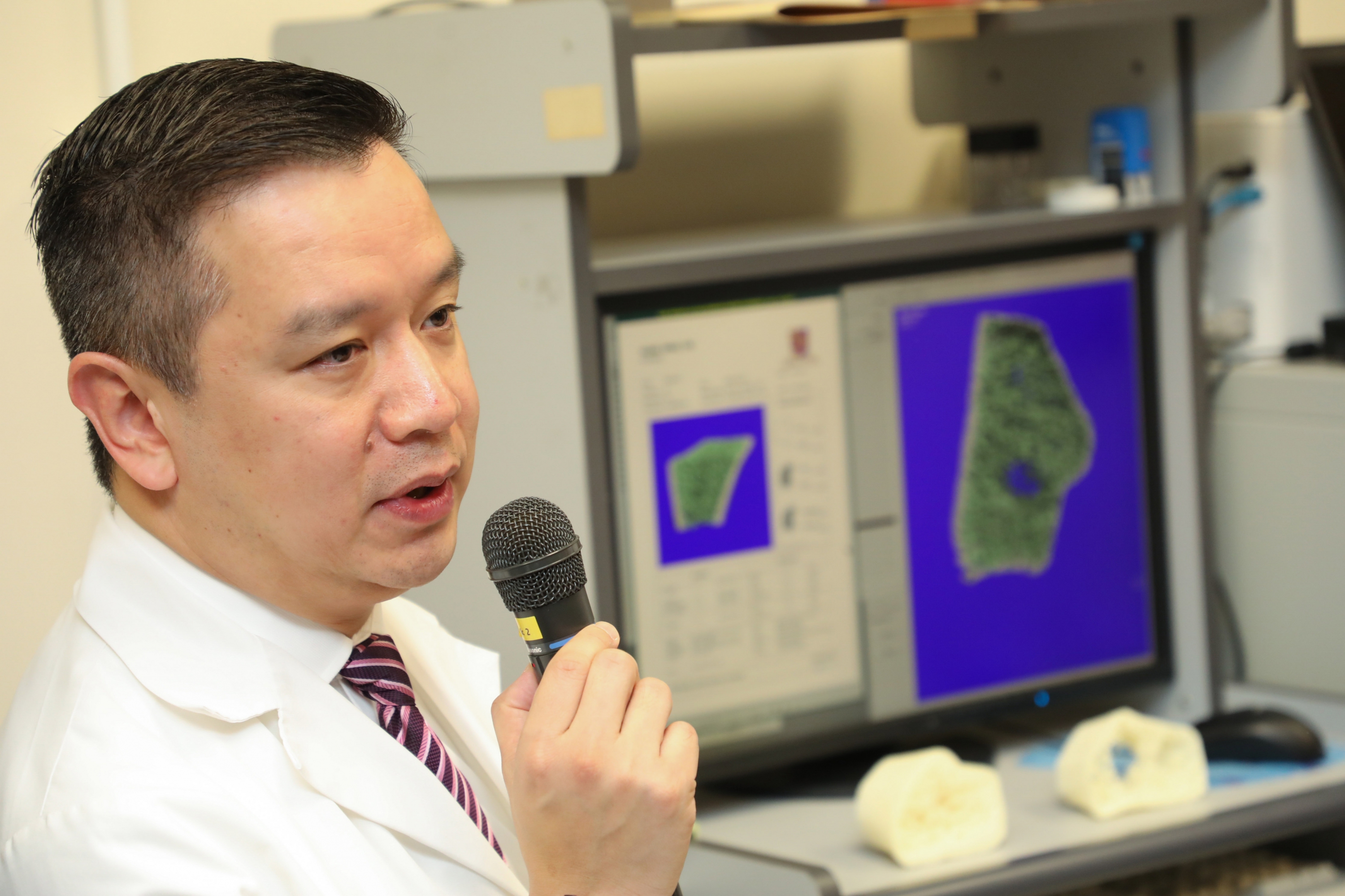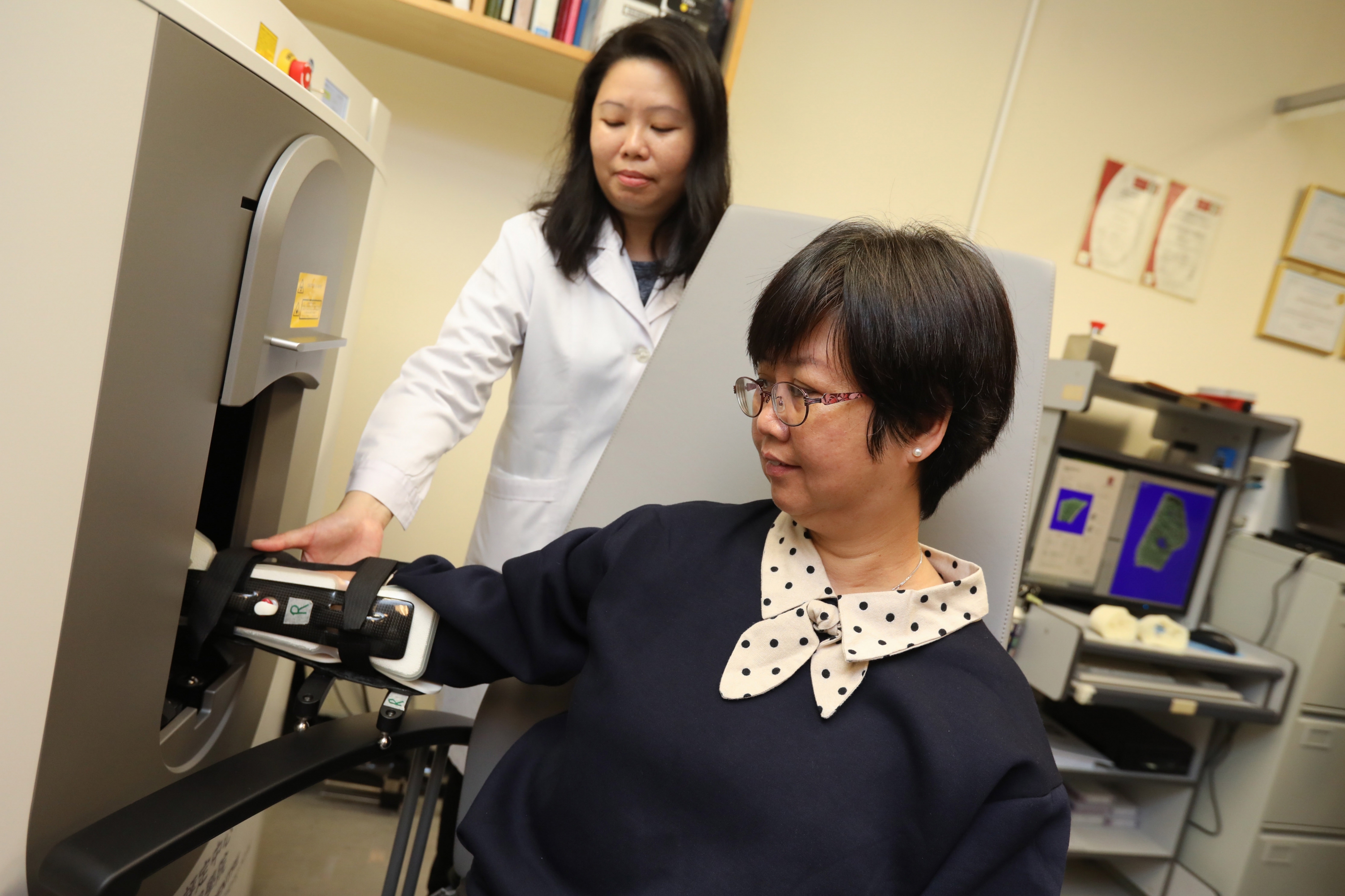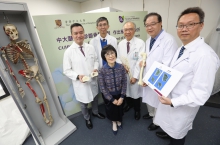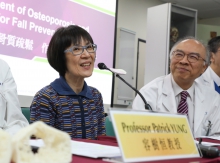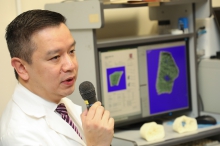CUHK
News Centre
CUHK Sets Asia’s First Three-dimensional Bone Density Standard For Early Diagnosis of Osteoporosis and Fracture Prevention
In Hong Kong, it is estimated that those aged over 50 years will increase to more than 60% of the population in 2050.1 Population aging is associated with an increase in musculoskeletal problems. Osteoporosis, the disease caused by the decrease in bone density and can lead to fragility fracture, is one of the problems that cannot be ignored. In this regard, the Faculty of Medicine at The Chinese University of Hong Kong (CUHK) has conducted a series of researches to reduce the impact of osteoporosis on patients and the medical burden caused by the disease through advanced diagnostic tools and innovative prevention programmes.
Based on years of clinical researches, the Department of Orthopaedics and Traumatology of the Faculty of Medicine at CUHK has set the first three-dimensional (3D) Bone Density Standard in Asia by using high-resolution peripheral quantitative computed tomography (HR-pQCT). The standard helps set bone density references for Chinese men and women of different age groups, thereby developing early diagnosis of osteoporosis and assessment of fracture risk to increase the awareness of patients so that necessary precautionary measures may be taken to minimise the risk of falling down, which leads to fracture. These findings have just been published in the Journal of Bone and Mineral Research.
15,000 osteoporotic fracture cases every year and the death rate is as high as 20%
There are 15,000 osteoporotic fracture cases every year and the death rate of these patients within one year is 20%, much higher than the 2% mortality rate of those at the same age but without osteoporotic fracture.
Distal forearm fracture, vertebral fracture and hip fracture are common in osteoporosis patients. Of these, the number of hip fracture cases is expected to double by 2031. Professor Patrick Shu Hang YUNG, Chairman of the Department of Orthopaedics and Traumatology of the Faculty of Medicine at CUHK, stated, “Fragility fracture requires surgical treatment but the operation and the post-operation rehabilitation are complex. Therefore, early diagnosis of osteoporosis is important in order to raise the awareness of the patients and reduce their risk of fractures caused by falls.”
CUHK installed the advanced diagnostic device to set Asia’s first bone density standard
Dual X-ray energy Absorptiometry (DXA) is the conventional standard for clinical diagnosis of osteoporosis. Total body composition, including fat mass, lean mass and total bone mineral density, can be obtained by whole body scan. But DXA can only provide 2D images, with insufficient bone density data for accurate prediction of the fragility fracture risk.
To solve this problem, CUHK installed the 3D imaging device HR-pQCT which can perform precise analysis of the bone micro-architecture and trabecular connectivity through scanning for calculating the bone strength.
The Department of Orthopaedics and Traumatology of the Faculty of Medicine at CUHK has conducted a study using HR-pQCT to collect the bone density data from over 1,000 individuals and set the first 3D Bone Density Standard in Asia. In 2015 to 2017, the research team carried out scanning with HR-pQCT on 1,072 healthy individuals aged 20 to 79 years old. The bone density of the participants’ distal radius and tibia were measured. By using the data, the bone density references of male and female of different age groups have been set.
The bone density standard helps medical professionals to judge if the bone loss in an individual is critical and predict the fragility fracture risk. The device is also important for studying treatment efficacy as it can monitor bone change during treatment without bone biopsy.
Professor Ling QIN from the Department of Orthopaedics and Traumatology of the Faculty of Medicine at CUHK, added, “HR-pQCT helps develop diagnosis of osteoporosis at early stage and differentiate bone metabolic diseases of different nature. In addition to assessing the hand and leg joints, the device can be used to assess knee joints which provide a new approach to the diagnosis and evaluation of osteoarthritis.”
Strengthen muscle exercises to reduce fracture risk due to falls
In fact, skeletal muscle mass, muscle force and physical performance of the human body degrade with age. Professor Timothy Chi Yui KWOK, Director of the CUHK Jockey Club Centre for Osteoporosis Care and Control of the Faculty of Medicine at CUHK, explained, “Our study results show that sarcopenia can be observed more frequently in men than women. The muscle strength and toughness of the patients are reduced and their ability in body balance is also weakened. Their risks of falls as well as fracture are thereby increased. So the public should pay attention to sarcopenia too.”
Osteoporosis patients may suffer bone fracture even from a slight collision. Professor Louis Wing Hoi CHEUNG, Associate Professor of the Department of Orthopaedics and Traumatology of the Faculty of Medicine at CUHK, said, “After diagnosis, it is essential to strengthen the muscle of osteoporosis patients in order to reduce their fracture risk from falls. Our clinical research proves that, besides doing exercises, non-pharmaceutical biophysical interventions like ‘vibration therapy’ improves muscle strength and balancing ability of osteoporosis patients. Hence, their rate of falls and fracture is reduced by 40%.”
Ongoing developments: Prevention of fall programme in community and interdisciplinary and multinational studies on osteoporosis
To increase public awareness of fracture prevention, CUHK has been organising different promotional activities in the community, such as providing anti-fall training for the older people and community workers. In the future, it hopes to conduct more interdisciplinary and multinational studies to strengthen the prevention and treatment of fractures, sarcopenia and osteoarthritis.
|
|
1International Osteoporosis Foundation Asia-Pacific Regional Audit (2013) https://www.iofbonehealth.org/
The Faculty of Medicine at CUHK has set the first 3D Bone Density Standard in Asia by using high-resolution peripheral quantitative computed tomography (HR-pQCT). (From left) Professor Patrick YUNG, Chairman of the Department of Orthopaedics and Traumatology; Professor Timothy KWOK, Director of the CUHK Jockey Club Centre for Osteoporosis Care and Control; Professor Fanny CHEUNG, Pro-Vice-Chancellor of CUHK; Professor Jack CHENG, CUHK Choh-Ming Li Research Professor of Orthopaedics and Traumatology; Professor Ling QIN and Professor Louis CHEUNG of the Department of Orthopaedics and Traumatology at CUHK Medicine.
Professor Fanny CHEUNG (left), Pro-Vice-Chancellor of CUHK, advises the youngsters to have balanced diet and do regular exercise to lower the chance of osteoporosis.
Professor Patrick YUNG, Chairman of the Department of Orthopaedics and Traumatology of the Faculty of Medicine at CUHK explains that HR-pQCT can perform precise analysis of the bone micro-architecture, thereby developing early diagnosis of osteoporosis.


